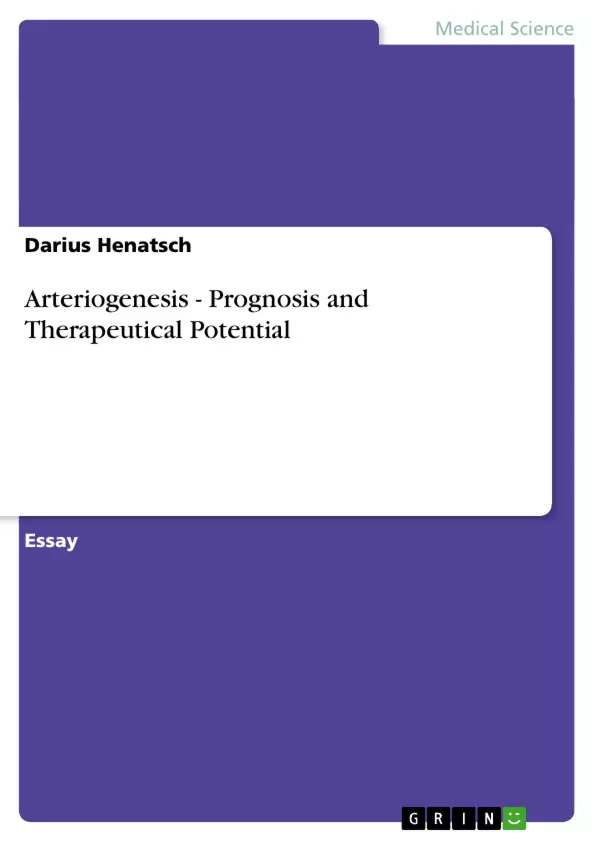Due to the fast growing field of molecular cardiology, mechanisms responsible for collateral artery growth (arteriogenesis) are widely unravelled. After coronary artery occlusion, flow shear stress induces endothelial cell expression and release of adhesion molecules and chemokines. Monocytes are attracted and transmigrate into the vessel wall to release pro-arteriogenic molecules. The process of collateral vessel growth is severely impaired in patients with different risk factors for atherosclerosis, as diabetes or hyperlipedemia. This can be attributed to the impaired migration capacity of monocytes towards pro-arteriogenic stimuli, like MCP-1 and VEGF-A. In these patients “at risk”, blood derived monocytes offer a possibility to predict the individual ability to form functional collaterals by an in vitro performed migration assay. Furthermore, growth factor therapy can be used to enhance and restore collateral growth in patients with impaired arteriogenesis. Here, the migration assay could perfectly be used to for individual adjustment of therapeutical interventions.
Inhaltsverzeichnis (Table of Contents)
- Introduction
- General Concepts of Arteriogenesis
- Those Who Play the Game
- The Endothelium
- Arteriogenic Stimuli
- MCP-1
- VEGF
- PIGF
- FGF
- How can it go wrong? Impairment of Arteriogenesis
- To the Clinic: Prognosis and Future Therapy
- Concrete Role of Monocytes
- The Way to Predict Collateral Growth
- Future Therapy
- Discussion and Conclusion
- References
Zielsetzung und Themenschwerpunkte (Objectives and Key Themes)
This paper provides a comprehensive overview of the mechanisms behind collateral artery growth (arteriogenesis), specifically focusing on its role in treating cardiovascular disease. The paper explores the influence of various factors, including risk factors, growth factors, and cell interactions, on the process of arteriogenesis.
- The process of arteriogenesis in relation to cardiovascular disease.
- The role of different cells and growth factors in arteriogenesis.
- The impact of risk factors on the process of arteriogenesis.
- The potential of arteriogenesis as a therapeutic strategy.
- The development of predictive tools for assessing collateral growth.
Zusammenfassung der Kapitel (Chapter Summaries)
The Introduction chapter provides a general overview of cardiovascular disease and its prevalence. The paper then discusses the significance of arteriogenesis as a natural escape mechanism in atherosclerosis and its contribution to tissue perfusion in patients with advanced coronary artery disease. The chapter also highlights the importance of understanding arteriogenesis for predicting collateral formation and potential therapeutic interventions.
The General Concepts of Arteriogenesis chapter explores the process of arteriogenesis in detail, contrasting it with angiogenesis and vasculogenesis. The chapter explains the importance of arteriogenesis in restoring adequate tissue perfusion after cardiac arterial occlusion and emphasizes the role of fluid shear stress as a key inducer of arteriogenesis. It also describes the morphological and cytoskeletal changes induced by shear stress in endothelial cells.
The Those Who Play the Game chapter delves into the cellular players involved in arteriogenesis, focusing on the endothelium and its response to shear stress. The chapter discusses the expression of adhesion molecules and chemokines by endothelial cells, their role in attracting monocytes, and the subsequent production of growth factors and proteases by macrophages. It also explains the importance of chemokines, particularly MCP-1, in recruiting inflammatory cells to the site of tissue hypoperfusion.
The How can it go wrong? Impairment of Arteriogenesis chapter investigates the factors that can impair arteriogenesis, including risk factors like hyperlipidemia and diabetes. The chapter explores the impact of these factors on the migration capacity of monocytes and the subsequent negative influence on collateral growth.
The To the Clinic: Prognosis and Future Therapy chapter discusses the clinical relevance of arteriogenesis, including its potential for prognostication and therapeutic interventions. The chapter explores the use of blood-derived monocytes for predicting individual ability to form functional collaterals and the potential of growth factor therapy for enhancing collateral growth in patients with impaired arteriogenesis.
Schlüsselwörter (Keywords)
Arteriogenesis, cardiovascular disease, coronary artery disease, myocardial infarction, angiogenesis, vasculogenesis, fluid shear stress, endothelial cells, smooth muscle cells, monocytes, macrophages, growth factors, chemokines, MCP-1, VEGF, PlGF, FGF, risk factors, hyperlipidemia, diabetes, prognosis, therapy.
- Quote paper
- Darius Henatsch (Author), 2008, Arteriogenesis - Prognosis and Therapeutical Potential , Munich, GRIN Verlag, https://www.grin.com/document/134742



